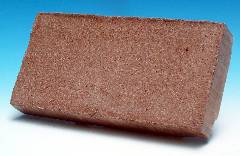A low cost, easy to produce solution

The geopolymer LTGS brick is an ideal construction technology for emerging countries, because it offers many characteristics that fulfils the population demands.
This brick uses a very cheap material available in great quantity: lateritic clay earth. This special and abundant earth, mixed with a simple geopolymer binder is compressed to give the shape of a brick then heated in a furnace. Heated at 85°C, LTGS brick is water stable and has enough compressive strength to build a wall. Heated at 250°C, it resists to freezing. At 450°C, its strength increases more, so that it is possible to manufacture structural elements like beams for doors and windows. Compared to a traditional brick fired at 1000°C in a kiln, the LTGS brick needs about eight times less energy for an equivalent strength. Contrary to a traditional brickyard, it requires less equipment and is less expensive to produce. A traditional brickyard must have a certain size before being profitable, whereas LTGS brick can be produced by small brickyards in a village or a small city with less equipment and finance.

Get a natural fresh house
But beyond its strength identical to traditional brick, its lower manufacturing cost and its low energy consumption, a house built out of LTGS brick will be naturally air-conditioned and fresher. This “interior comfort” quality or “passive cooling”, alike pisé, rammed earth or other earth materials, is related to the essential physical and chemical characteristics of geopolymers for LTGS bricks. These geopolymers, which constitutes the matrix of the brick, have zeolitic properties, i.e. the property “to breathe”, to be in constant hygrometrical balance with the interior of a dwelling in order to be an excellent insulation material against heat. We know that, in hot and dry areas, the traditional earth material is providing a comfort much higher than modern insulating material used in industrialized northern countries. LTGS bricks absorb moisture. At night, they store condensation moisture from the surrounding air. During the day, they release this moisture, either inside the house if the relative humidity should be compensated, or outside. So there is evaporation, therefore a drop in the temperature of the material, therefore a cooling of the house and insulation against the heat!
This technology may be used by anyone

The LTGS brick technology was patented in France under the number 80 20386, filed on the 23 September 1980. It is now in the public domain, which means any person in the world can commercially exploit it without the agreement of the first owner, our company CORDI-Géopolymère. However, this system is not understandable by the lay man or the handy person who wants to build a wall in his garden, and unfortunately grocery stores are not selling the required materials! The person who wishes to manufacture LTGS bricks needs chemical and material science backgrounds because it requires some equipments and to develop – invent the right formula for each lateritic soil.
How to know more?
Download the technical paper #14 Geopolymeric Cross-Linking (LTGS) and Building Materials (70 KB) from the Geopolymer’88 Proceedings.
In the recently updated book Geopolymer Chemistry & Applications, the Low-Energy ceramic manufacture and low-tech LTGS bricks are thoroughly outlined in Chapter 23. Also, additional scientific papers can be downloaded at the Library.
Watch a video presentation of this technology
Prof. Joseph Davidovits presented at the Ceramics and Brotherhood Symposium, Verona, Italy, July 4th 2008, the manufacture of the LTGS bricks, an opportunity for small environment-friendly productions in construction materials, for Africa, Asia, America, Middle East and Oceania. The bricks are set at low temperature, low energy and low cost, but with first-class quality and strength.
Click here to download the free video in full lentgh, high quality.
22min 06s – 50 MB – 640×480 30fps – MPEG4 H.264 AVC format
Watch it with Quicktime, VLC, Mplayer, or any MPEG4 H.264 AVC player.
What do I need to implement this technology?
You will find in the above paper all the required information in order to develop the LTGS brick technology by yourself. You need to gather a team of expertise: a geologist to find the right lateritic soil, a material scientist to search for the right chemical material provider and to finalize the chemical formula, and a specialist in manufacturing fired clay bricks. They will find all information needed in the above paper.


